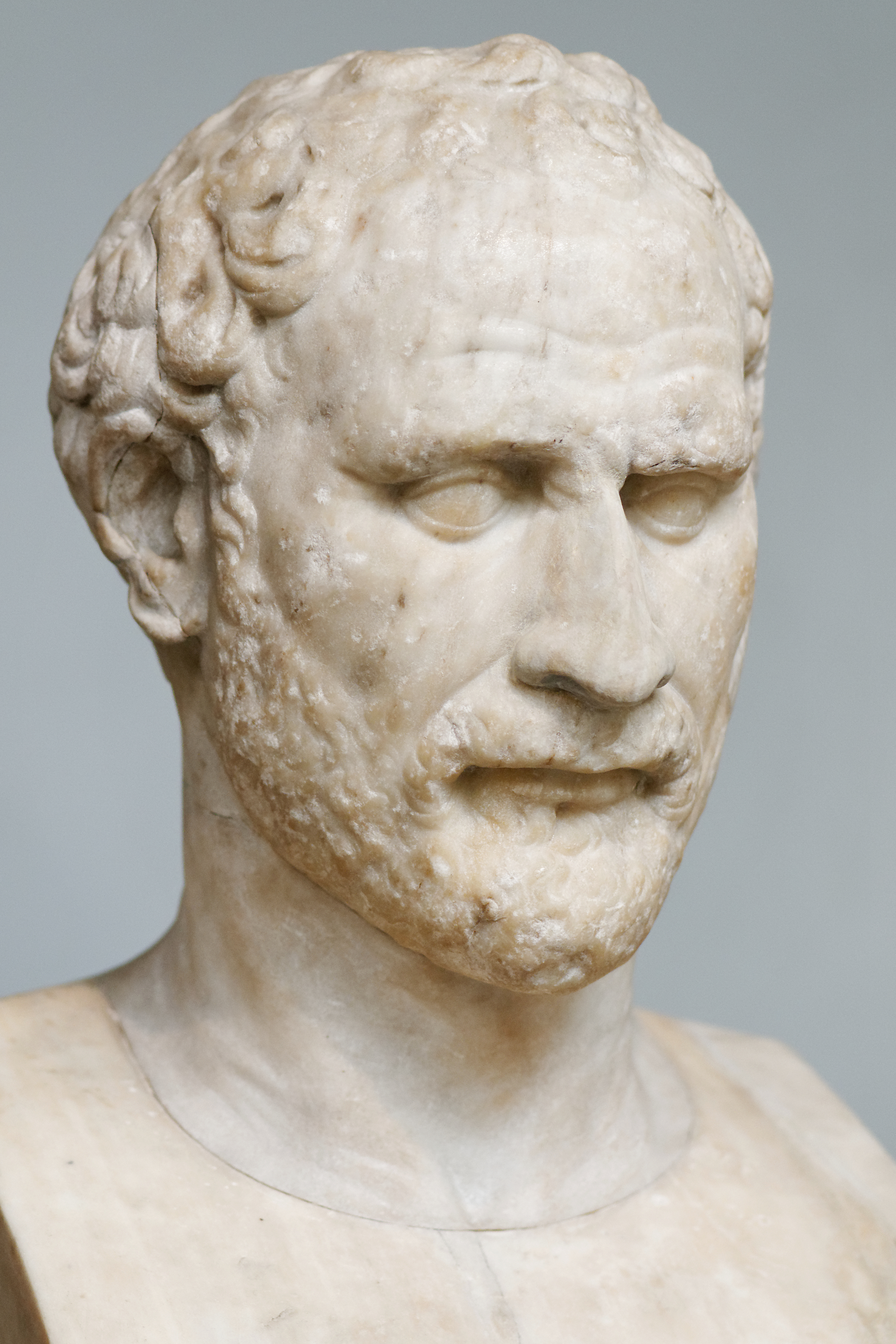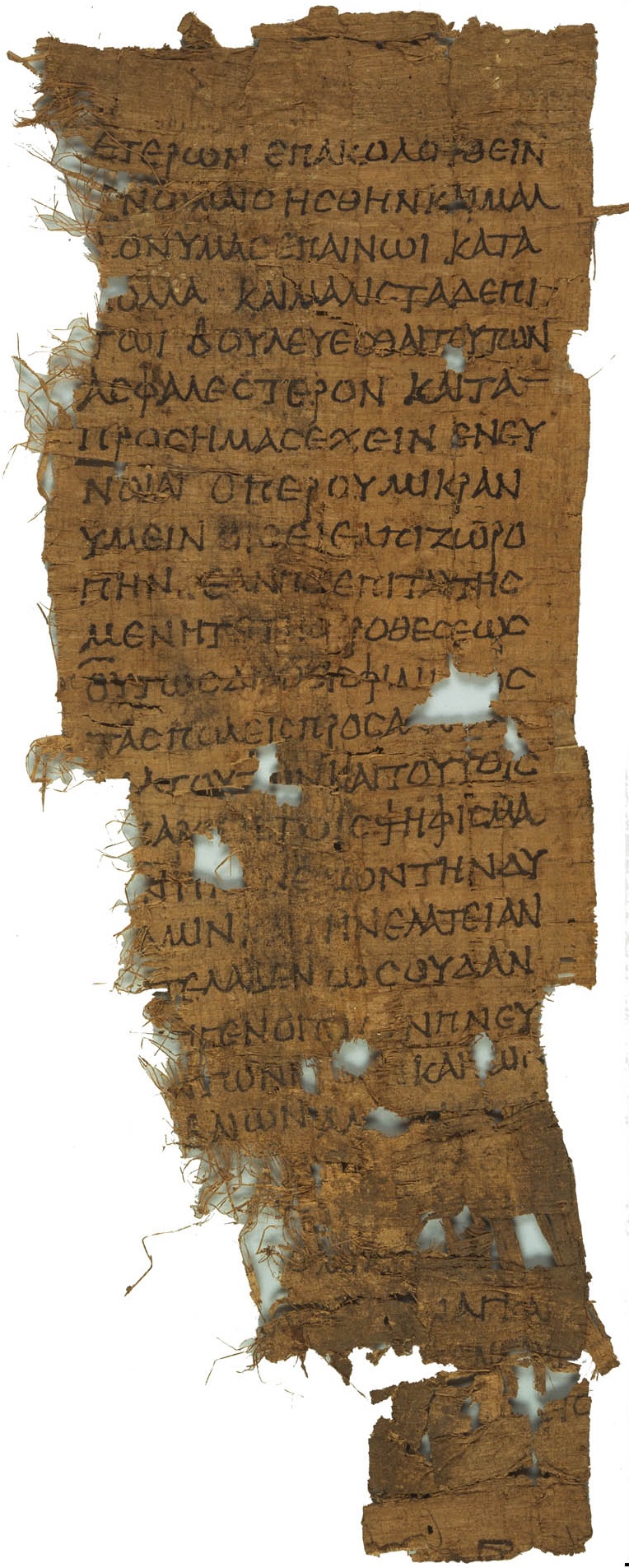|
Papyrus Oxyrhynchus 25
Papyrus Oxyrhynchus 25 (P. Oxy. 25) is a fragment of Demosthenes' speech "On the Crown", written in Greek. It was discovered by Bernard Pyne Grenfell and Arthur Surridge Hunt in 1897 at Oxyrhynchus in Egypt, and first published by them in 1898.P. Oxy. 25 at the Oxyrhynchus Online The manuscript was written on in the form of a roll, and dates to the third century. It measures 95 by 80 mm, and contains 11 lines of text. The text is written in a large thick formal |
Demosthenes
Demosthenes (; el, Δημοσθένης, translit=Dēmosthénēs; ; 384 – 12 October 322 BC) was a Greek statesman and orator in ancient Athens. His orations constitute a significant expression of contemporary Athenian intellectual prowess and provide insight into the politics and culture of ancient Greece during the 4th century BC. Demosthenes learned rhetoric by studying the speeches of previous great orators. He delivered his first judicial speeches at the age of 20, in which he successfully argued that he should gain from his guardians what was left of his inheritance. For a time, Demosthenes made his living as a professional speechwriter ( logographer) and a lawyer, writing speeches for use in private legal suits. Demosthenes grew interested in politics during his time as a logographer, and in 354 BC he gave his first public political speeches. He went on to devote his most productive years to opposing Macedon's expansion. He idealized his city and stro ... [...More Info...] [...Related Items...] OR: [Wikipedia] [Google] [Baidu] |
Friedrich Blass
Friedrich Blass (22 January 1843, Osnabrück5 March 1907, Halle) was a German classical scholar. Biography After studying at Göttingen and Bonn from 1860 to 1863, Blass lectured at several gymnasia and at the University of Königsberg. In 1876 he was appointed extraordinary professor of classical philology at Kiel, and ordinary professor in 1881. In 1892 he accepted a professorship at Halle, where he later died. He frequently visited England, and was intimately acquainted with leading British scholars. He received an honorary degree from Dublin University in 1892, and his readiness to place the results of his labours at the disposal of others, together with the courtesy and kindliness of his disposition, won the respect of all who knew him. Blass is chiefly known for his works in connection with the study of Greek oratory: ''Die Attische Beredsamkeit von Alexander bis auf Augustus'' (1865); ''Die attische Beredsamkeit'' (1868–1880; 2nd ed., 1887–1898), his greatest work; ... [...More Info...] [...Related Items...] OR: [Wikipedia] [Google] [Baidu] |
Papyrus Oxyrhynchus 230
Papyrus Oxyrhynchus 230 (P. Oxy. 230 or P. Oxy. II 230) is a fragment of the '' De Corona'' by Demosthenes, written in Greek. It was discovered in Oxyrhynchus. The manuscript was written on papyrus in the form of a roll. It is dated to the second century. Currently, it is housed in the Milton S. Eisenhower Library of the Johns Hopkins University in Baltimore.P. Oxy. 230 at the Oxyrhynchus Online Description The document was written by an unknown copyist. It contains part of the text of the ''De Corona'' (40-47) by Demosthenes. The measurements of the fragment are 280 by 210 mm. The text is written in a round, rather irregular |
Papyrus Oxyrhynchus 26
Papyrus Oxyrhynchus 26 (P. Oxy. 26) is a fragment of ''Prooimia Demegorica'' (26-29) by Demosthenes, written in Greek. It was discovered by Grenfell and Hunt in 1897 in Oxyrhynchus. The fragment is dated to the second century. It is housed in the British Library (Department of Manuscripts). The text was published by Grenfell and Hunt in 1898.P. Oxy. 26 at the Oxyrhynchus Online The manuscript was written on in the form of a roll. The measurements of the fragment are 115 by 526 mm. The text on recto is written in a medium-sized |
Papyrus Oxyrhynchus 24
Papyrus Oxyrhynchus 24 (P. Oxy. 24) is a fragment of Chapter X of Plato's ''Republic'', written in Greek. It was discovered by Grenfell and Hunt in 1897 in Oxyrhynchus. The fragment is dated to the third century. It is housed in the Beinecke Rare Book and Manuscript Library at Yale University. The text was published by Grenfell and Hunt in 1898.P. Oxy. 24 at the Oxyrhynchus Online The manuscript was written on in the form of a roll. The measurements of the fragment are 46 by 74 mm. The fragment contains 10 lines of text. The text is written in a medium-sized sloping |
Oxyrhynchus Papyri
The Oxyrhynchus Papyri are a group of manuscripts discovered during the late nineteenth and early twentieth centuries by papyrologists Bernard Pyne Grenfell and Arthur Surridge Hunt at an ancient rubbish dump near Oxyrhynchus in Egypt (, modern ''el-Bahnasa''). The manuscripts date from the time of the Ptolemaic (3rd century BC) and Roman periods of Egyptian history (from 32 BC to the Muslim conquest of Egypt in 640 AD). Only an estimated 10% are literary in nature. Most of the papyri found seem to consist mainly of public and private documents: codes, edicts, registers, official correspondence, census-returns, tax-assessments, petitions, court-records, sales, leases, wills, bills, accounts, inventories, horoscopes, and private letters. Although most of the papyri were written in Greek, some texts written in Egyptian ( Egyptian hieroglyphics, Hieratic, Demotic, mostly Coptic), Latin and Arabic were also found. Texts in Hebrew, Aramaic, Syriac and Pahlavi have so far ... [...More Info...] [...Related Items...] OR: [Wikipedia] [Google] [Baidu] |
Johns Hopkins University
Johns Hopkins University (Johns Hopkins, Hopkins, or JHU) is a private university, private research university in Baltimore, Maryland. Founded in 1876, Johns Hopkins is the oldest research university in the United States and in the western hemisphere. It consistently ranks among the most prestigious universities in the United States and the world. The university was named for its first benefactor, the American entrepreneur and Quaker philanthropist Johns Hopkins. Hopkins' $7 million bequest to establish the university was the largest Philanthropy, philanthropic gift in U.S. history up to that time. Daniel Coit Gilman, who was inaugurated as :Presidents of Johns Hopkins University, Johns Hopkins's first president on February 22, 1876, led the university to revolutionize higher education in the U.S. by integrating teaching and research. In 1900, Johns Hopkins became a founding member of the American Association of Universities. The university has led all Higher education in the U ... [...More Info...] [...Related Items...] OR: [Wikipedia] [Google] [Baidu] |
Milton S
Milton may refer to: Names * Milton (surname), a surname (and list of people with that surname) ** John Milton (1608–1674), English poet * Milton (given name) ** Milton Friedman (1912–2006), Nobel laureate in Economics, author of '' Free to Choose'' Places Australia * Milton, New South Wales * Milton, Queensland, a suburb of Brisbane ** Milton Courts, a tennis centre ** Milton House, Milton, a heritage-listed house ** Milton railway station, Brisbane ** Milton Reach, a reach of the Brisbane River ** Milton Road, an arterial road in Brisbane Canada * Milton, Newfoundland and Labrador * Milton, Nova Scotia in the Region of Queens Municipality * Milton, Ontario ** Milton line, a commuter train line ** Milton GO Station * Milton (electoral district), Ontario ** Milton (provincial electoral district), Ontario * Beaverton, Ontario a community in Durham Region and renamed as Beaverton in 1835 * Rural Municipality of Milton No. 292, Saskatchewan New Zealand * Milton, N ... [...More Info...] [...Related Items...] OR: [Wikipedia] [Google] [Baidu] |
Karl Wilhelm Dindorf
Karl Wilhelm Dindorf ( la, Guilielmus Dindorfius; 2 January 1802 – 1 August 1883) was a German classical scholar. He was born and died at Leipzig. From his earliest years he showed a strong taste for classical studies, and after completing F. Invernizi's edition of Aristophanes at an early age, and editing several grammarians and rhetoricians, he was in 1828 appointed extraordinary professor of literary history in his native city. Disappointed at not obtaining the ordinary professorship when it became vacant in 1833, he resigned his post in the same year, and devoted himself entirely to study and literary work. His attention had at first been chiefly given to Athenaeus, whom he edited in 1827, and to the Greek dramatists, all of whom he edited separately and combined in his ''Poetae scenici Graeci'' (1830 and later editions). He also wrote a work on the metres of the Greek dramatic poets, and compiled special lexicons to Aeschylus and Sophocles. He produced an edition of Sophoc ... [...More Info...] [...Related Items...] OR: [Wikipedia] [Google] [Baidu] |
On The Crown
"On the Crown" ( grc, Ὑπὲρ Κτησιφῶντος περὶ τοῦ Στεφάνου, ''Hyper Ktēsiphōntos peri tou Stephanou'') is the most famous judicial oration of the prominent Athenian statesman and orator Demosthenes, delivered in 330 BC. Historical background Despite the unsuccessful ventures against Philip II of Macedon and Alexander the Great, the Athenian people still respected and admired Demosthenes, maybe even more than the pro-Macedonian politicians, especially Demades and Phocion, who ruled the city during this period. In 336 BC the orator Ctesiphon proposed that Athens honor Demosthenes for his services to the city by presenting him, according to custom, with a golden crown. This proposal became a political issue in 330 BC, and Aeschines prosecuted Ctesiphon for having violated the law on three points: *For making false allegations in a state document. *For unlawfully conferring a crown to a state official (Demosthenes) who had not yet rendered a report of ... [...More Info...] [...Related Items...] OR: [Wikipedia] [Google] [Baidu] |
Rough Breathing
In the polytonic orthography of Ancient Greek, the rough breathing ( grc, δασὺ πνεῦμα, dasỳ pneûma or ''daseîa''; la, spīritus asper) character is a diacritical mark used to indicate the presence of an sound before a vowel, diphthong, or after rho. It remained in the polytonic orthography even after the Hellenistic period, when the sound disappeared from the Greek language. In the monotonic orthography of Modern Greek phonology, in use since 1982, it is not used at all. The absence of an sound is marked by the smooth breathing. The character, or those with similar shape such as , have also been used for a similar sound by Thomas Wade (and others) in the Wade–Giles system of romanization for Mandarin Chinese. Herbert Giles and others have used a left (opening) curved single quotation mark for the same purpose; the apostrophe, backtick, and visually similar characters are often seen as well. History The rough breathing comes from the left-hand half of th ... [...More Info...] [...Related Items...] OR: [Wikipedia] [Google] [Baidu] |
Uncial Script
Uncial is a majuscule Glaister, Geoffrey Ashall. (1996) ''Encyclopedia of the Book''. 2nd edn. New Castle, DE, and London: Oak Knoll Press & The British Library, p. 494. script (written entirely in capital letters) commonly used from the 4th to 8th centuries AD by Latin and Greek scribes. Uncial letters were used to write Greek and Latin, as well as Gothic and Coptic. Development Early uncial script most likely developed from late rustic capitals. Early forms are characterized by broad single-stroke letters using simple round forms taking advantage of the new parchment and vellum surfaces, as opposed to the angular, multiple-stroke letters, which are more suited for rougher surfaces, such as papyrus. In the oldest examples of uncial, such as the fragment of '' De bellis macedonicis'' in the British Library, of the late 1st-early 2nd century, all of the letters are disconnected from one another, and word separation is typically not used. Word separation, however, is characteri ... [...More Info...] [...Related Items...] OR: [Wikipedia] [Google] [Baidu] |




